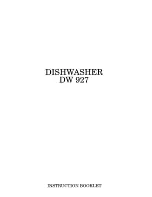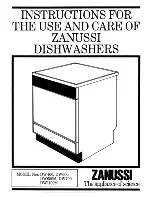
8
Preparing & Loading Dishes
Scrape away large pieces of food, bone, pits,
toothpicks, etc. The wash system will remove
remaining food particles. Gently scrape away
burned-on food with a non-scratch utensil or let
dish soak before before loading them into the
dishwaher (See Figure 1). Empty liquids from
glasses and cups.
Foods containing vegetable oil and/or chemical
additives such as mustard, mayonnaise, vinegar,
lemon juice or tomato-based products may cause
discoloration of stainless steel and plastics if
allowed to sit for a long period of time. Unless the
dishwasher is to be operated at once, it is best to
rinse off these food soils.
•
Load racks so that large items do not
prevent the detergent dispenser from
opening.
•
Check dishware manufacturer's
recommendations before washing
items in question.
•
If the dishwasher drains into a food
disposal,
be sure disposal is
completely empty before starting
dishwasher.
The top rack is optimized for flexibility in loading a
wide variety of items but especially cups, glasses,
stemware, small plates and small bowls.
Be sure that nothing protrudes through the bottom
of the rack or can shift to protrude so that the
middle spray arm is blocked. If in doubt, give the
arm a spin to see if there is interference.
10 place settings standard loading pattern
Figure 1
LOADING THE TOP RACK
DISH PREPARATION
Tips for Loading the Racks -
Soil is removed when water is sprayed on each
surface. For optimal cleaning, load dishware and
silverware so that it is not touching each other.
Then every surface is exposed to the cleaning jets.
Corner positions are the hardest to reach for spray
arms. It is best to put the tallest glasses away
from the corner positions of the upper rack.
Always place dishware with open ends facing down
for best cleaning and drying.
Some dishes have rims or indentations that may
capture and hold water. For improved drying use
the slopes built into the rack and the position of the
tines to place this dishware so that the surfaces are
not horizontal to help drain as much out as
possible.
Load delicate items securely in the rack without
allowing them to touch other dishware. This will
minimize the chance that they will tip or collide with
other dishware and become damaged when the
rack is moved or when the spray jets are turned on.
In some dishwashers it is not safe to load glasses
or plastics into the lower rack - mainly because
they have an exposed heater just below it. This is
not one of them. The same strong, gentle jets and
the same temperature water is applied to the
dishware in both the upper and lower racks. You’re
free to place the dishware where it fits best.
Summary of Contents for EIDW5905
Page 72: ......









































